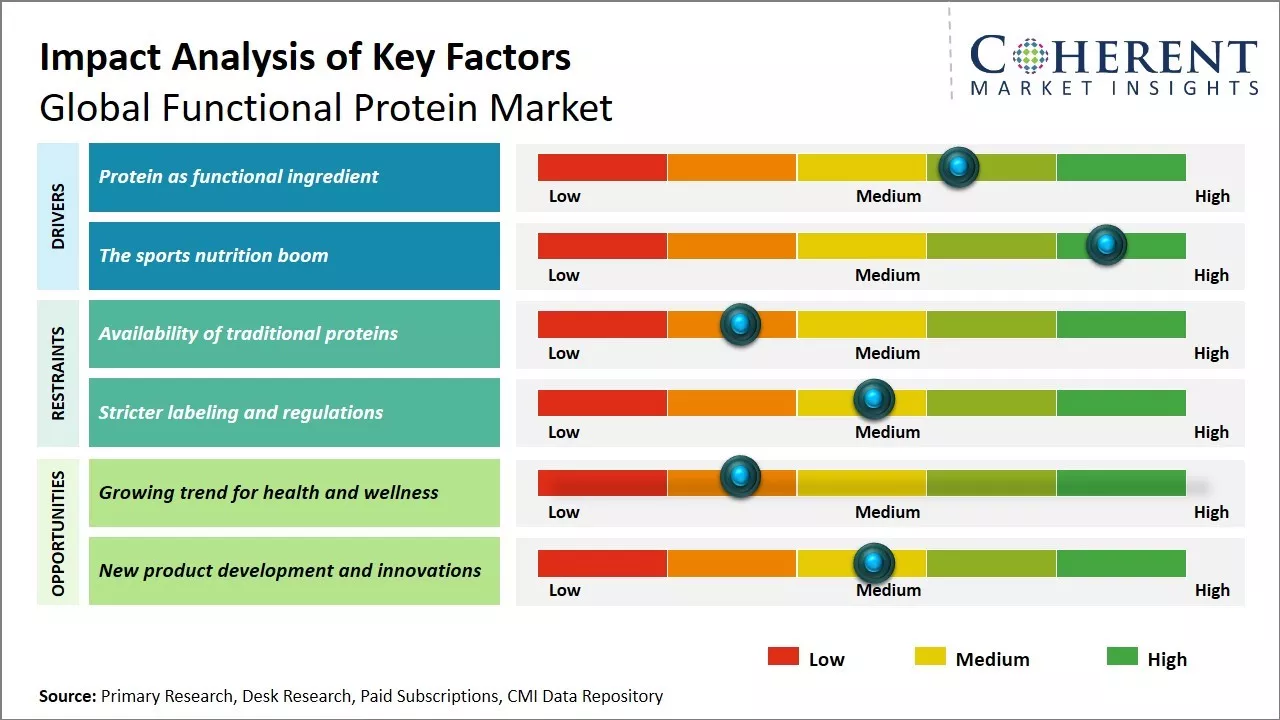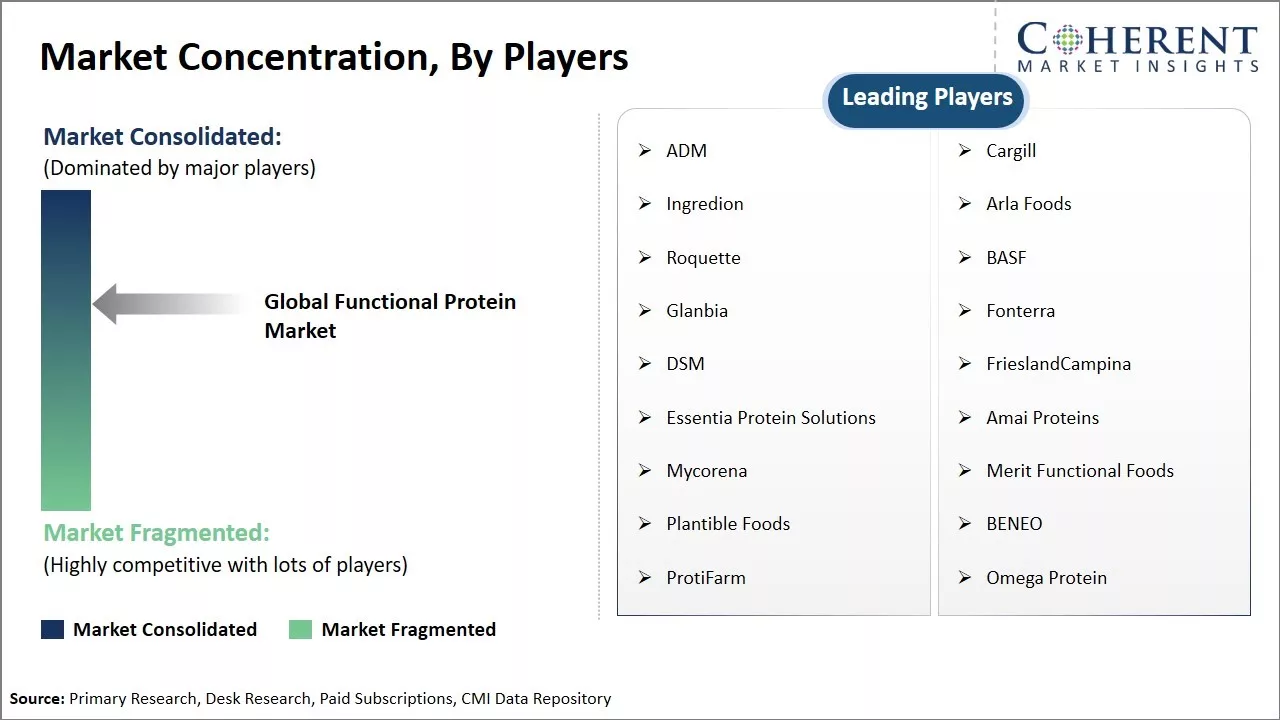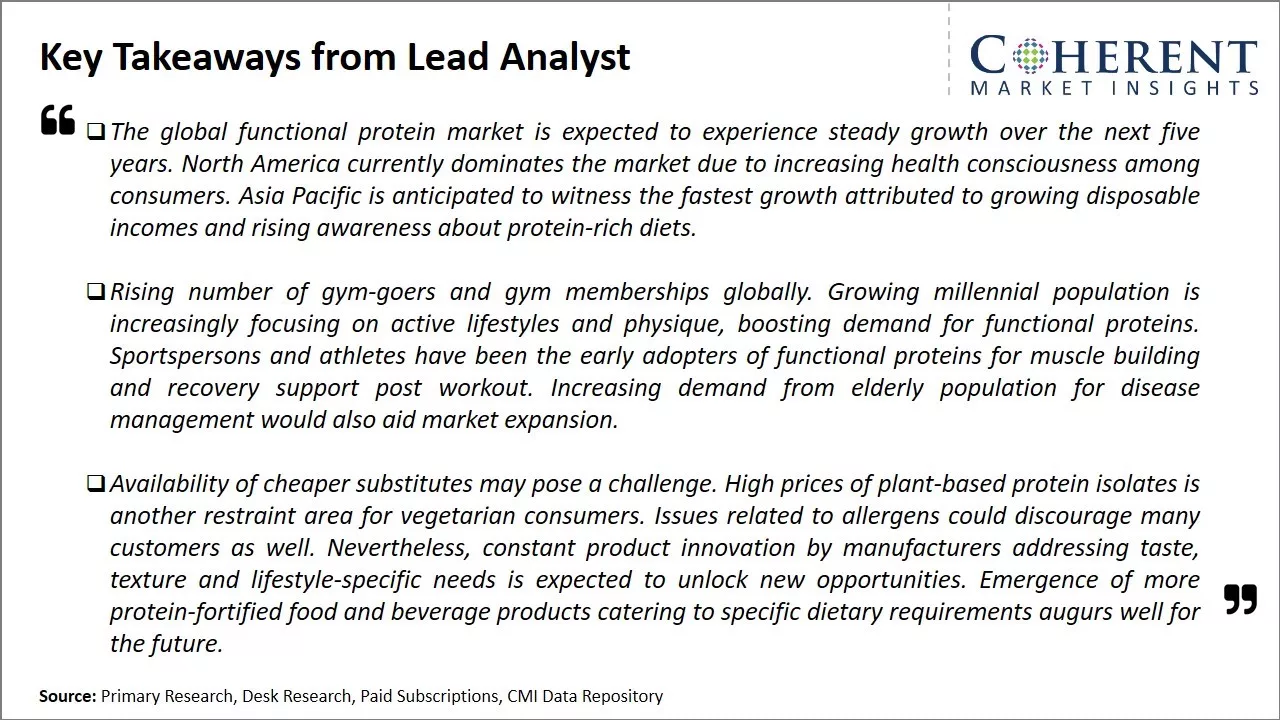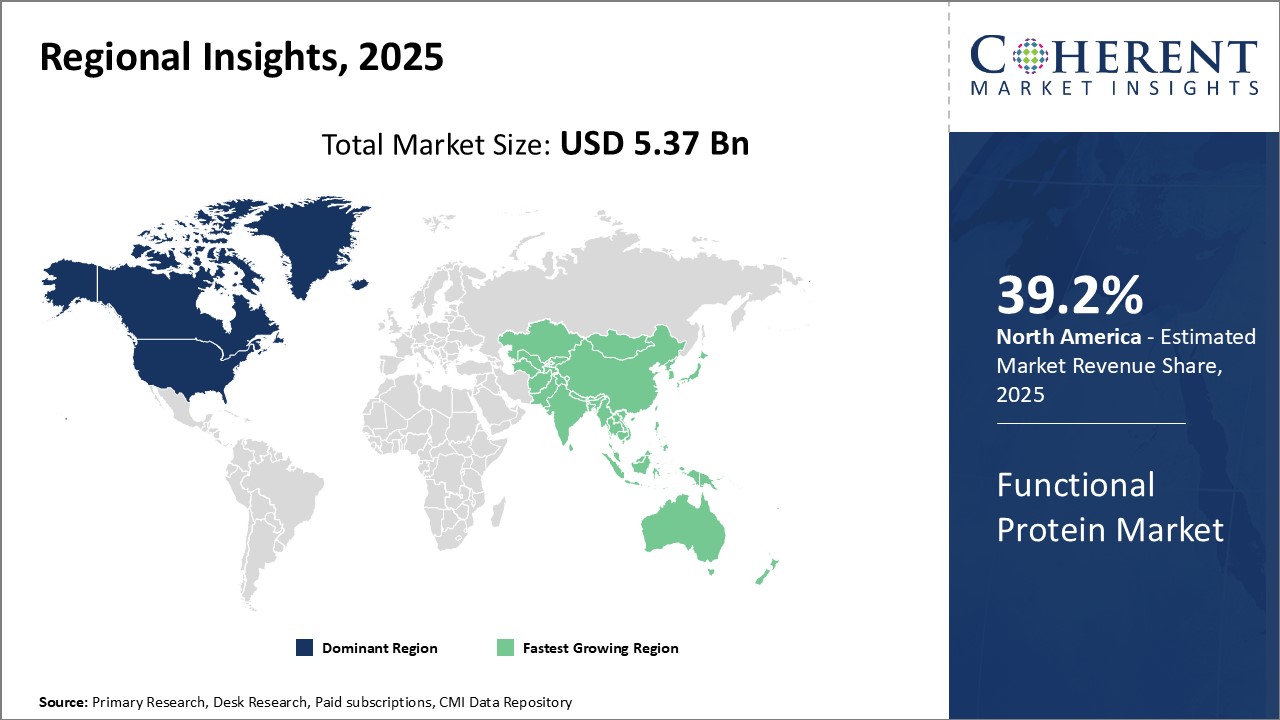Functional Protein Market Size and Trends
The global functional protein market is estimated to be valued at USD 5.37 Bn in 2025 and is expected to reach USD 7.66 Bn by 2032, exhibiting a compound annual growth rate (CAGR) of 5% from 2025 to 2032.

Discover market dynamics shaping the industry: Download Free Sample
The functional protein market is expected to grow steadily during the forecast period. Rising consumer preference for healthy and nutritious food is expected to drive the demand. Protein fortification and enrichment in various food products such as beverages, baked goods, dairy alternatives, and others is increasing globally which is expanding the application scope of functional protein. Growing vegan population and launch of innovative plant-based protein products are some of the emerging market trends. Advancements in protein extraction and processing technologies are also supporting the market growth. However, high production cost and strict international quality standards and regulations for new ingredients are some of the challenges for the market.
Protein as functional ingredient
Global food and beverage market has witnessed tremendous growth and transformation in recent years. For instance, on June 21, 2023, according to the report published by the Food and Drink Federation, an organization of U.K. food and drink industry, the food and drink industry was the U.K.’s largest manufacturing sector. According to the same source, U.K.’s 12,460 food and drink manufacturing businesses were committed in investing, with total business investment in the industry equaling USD 3.33 Bn, down by 22.7% from 2021, following tough business conditions.
Consumers are increasingly aware of the link between diet and health, and seeking products that provide added nutritional benefits beyond basic nourishment. One of the key trends gaining significant traction is the use of high quality plant and animal proteins as functional ingredients. Many brands are enriching their products with proteins sourced from whey, casein, soy, peas, brown rice, and others that are easy to digest and complement the existing macronutrient profile. Protein-fortified foods and beverages cater to the growing wellness needs of health-conscious individuals. Research shows that adequate protein intake plays an important role in muscle growth, weight management, and lowering the risk of many lifestyle diseases. The protein craze is driving demand not just among bodybuilders and athletes but also the general population keen to lead an active lifestyle.
Market Concentration and Competitive Landscape

Get actionable strategies to beat competition: Download Free Sample
The sports nutrition boomAnother key growth driver has been the burgeoning sports nutrition and supplements industry. For instance, in October 2022, according to the data published by the Council for Responsible Nutrition (CRN), the leading trade association for the dietary supplement and functional food industry, sports nutrition supplements had witnessed a significant increase in use since last year, up five points to 39%. Regular workouts and competitive fitness scene have entered the mainstream in the last decade. People from different age groups wish to enhance performance, gain strength and build lean muscle with the aid of supplements scientifically backed with the right macro and micronutrients including protein.
Protein requirements are set to increase multi-fold for endurance athletes, bodybuilders, and other sports enthusiasts. Market shelves stock an array of protein powders catering to gender-specific needs along with benefits like easy digestion, enhanced uptake and varying protein sources for grass-fed, sugar-free, and plant-based options. Additional protein absorbed in the right ratio post-workout helps faster recovery and prevents muscle to breakdown. Sports drinks, bars, and gels also leverage high protein content to meet explosive calorie requirements before, during and after training.

To learn more about this report, Download Free Sample
Market Challenges: Availability of traditional proteinsGlobal functional protein market faces several challenges in the near future. Traditional proteins are already well-established and customers may be reluctant to switch to newer functional variants. Consumers are wary of E-numbers and artificial ingredients in foods. High research and production costs make functional proteins more expensive as compared to their conventional equivalents. Customer education on the health benefits of these proteins is another hurdle to overcome.
Market Opportunity: Growing trend for health and wellness
However, the market also presents several opportunities. The health and wellness trend is continually growing as more people aim to supplement their diets and lifestyles. As disposable incomes rise in developing nations, demand for premium health-focused products will increase. Niche and customized products catering to specific diets or medical conditions also present an avenue for market expansion.

Discover high revenue pocket segments and roadmap to it: Download Free Sample
Insights, By Type: Consumer demand for health boosting nutritious proteins drives whey protein segment growthBy type, whey protein contributes the 39.4% share of the market owing to its widespread popularity and numerous proven health benefits. With increasing awareness about fitness and nutrition, consumers are actively seeking proteins that can aid muscle growth and weight management in a natural way. Whey protein isolates and concentrates have emerged as a versatile source to meet such needs due to their high biological value and rich composition of essential amino acids. Numerous clinical trials have validated whey's potential to build strength and boost recovery after workout. Its fast-digesting nature makes it suitable for daily consumption among active individuals and athletes. Beyond gym-goers, even general population is incorporating whey into smoothies, pancakes and desserts to fulfill their daily protein requirement in a tasty format. Rapidly growing sports nutrition sector and diverse new product inventions have further expanded whey protein's outreach.
Insights, By Source: Rising adoption of plant-based proteins drives plant segment growth
By source, animal contributes the 33.1% share however plant segment is emerging at a rapid pace. With growing preference for vegan and vegetarian diets due to ethical, environmental or allergen-related concerns, alternatives to dairy proteins are witnessing increased uptake. Soy protein has remained a popular choice for decades due to its complete protein profile resembling meat and eggs. However, newer plant sources such as pea, rice, and pulses are fast catching up riding the clean label and sustainability trends. Their neutral taste makes them highly versatile for formulation across food & beverage types. Soy allergy issues have also opened doors for novel plant options to cater to sensitive groups. Furthermore, investment in tech-enabled protein extraction is enhancing plant proteins' functionalities to match animal equivalents, thereby removing past limitations. This has upscale their acceptance in performance nutrition and clinical applications.
Insights, By Application: Functional benefits augment functional food demand in application segment
By application, functional food contributes the 38.3% share on the back of its diverse utility and strong appeal among preventive health seekers. Incorporating extra proteins into regular diet has manifold wellness perks right from building lean muscle to controlling obesity, blood pressure, and cholesterol. Functional foods enriched with proteins fit right into such lifestyle and help attain nutrition goals in enjoyable formats. Dairy and cereal-based functional foods have established the segment for long but acceptance is spreading to various cuisines worldwide via innovative formulations. Protein bars and beverages particularly draw younger demographics by addressing their on-the-go needs seamlessly. Clinical research validating specific health-optimizing effect of certain proteins also encourages food companies to fortify corresponding protein-based offerings. Sports federation’s promotions and fitness influencer’s recommendations further boost the image of high protein diets and related functional foods.
Regional Insights

Need a Different Region or Segment? Download Free Sample
North America has been dominating the global functional protein market share of 39.2%. The region is home to some of the largest protein manufacturers and users. There is a strong demand for high quality protein alternatives in the U.S. due to increasing health concerns. Many new protein-rich food and beverage products are being launched regularly to cater to this demand.
Being the early adopters of active lifestyle and wellness trends, North American consumers are willing to pay premium prices for functional foods. Leading food companies in the region have also strengthened their protein offerings organically as well as through strategic acquisitions. The regulatory environment supports innovation in new delivery forms of protein. Furthermore, North America enjoys proximity to key manufacturing bases that helps minimize costs.
The Asia Pacific region has emerged as the fastest growing market for functional proteins globally. There is a massive untapped market potential due to the rising health awareness and disposable income. Countries like China and India account for over half the world's population and represent lucrative high-growth opportunities. Local protein startups as well as international players are investing heavily in building local manufacturing and research and development (R&D) capabilities.
Changing diets and busy urban lifestyles are leading more Asians to consume convenient packaged snacks and beverages with added protein. The flexible trade policies further encourage global companies to establish local production units. Moreover, Asia Pacific is a major exporter of agri-commodities used in protein production. This gives regional players a unique advantage in sourcing raw materials at competitive costs. The growing middle-class population will continue propelling the demand for healthy and nutritious protein options.
Market Report Scope
Global Functional Protein Market Report Coverage
| Report Coverage | Details | ||
|---|---|---|---|
| Base Year: | 2024 | Market Size in 2025: | USD 5.37 Bn |
| Historical Data for: | 2020 To 2024 | Forecast Period: | 2025 To 2032 |
| Forecast Period 2025 to 2032 CAGR: | 5.2% | 2032 Value Projection: | USD 7.66 Bn |
| Geographies covered: |
|
||
| Segments covered: |
|
||
| Companies covered: |
ADM, Cargill, Ingredion, Arla Foods, Roquette, BASF, Glanbia, Fonterra, DSM, FrieslandCampina, Essentia Protein Solutions, Amai Proteins, Mycorena, Merit Functional Foods, Plantible Foods, BENEO, ProtiFarm, Omega Protein |
||
| Growth Drivers: |
|
||
| Restraints & Challenges: |
|
||
Uncover macros and micros vetted on 75+ parameters: Get instant access to report
Functional Protein Industry News
- In December 2020, Cargill expanded opportunities for innovation in plant-based foods with addition of pea protein to European ingredient portfolio.
- Ingredion acquired 100% of Verdient Foods (Vanscoy, SK) in November 2020. By adding two new manufacturing facilities in Canada, the acquisition increased Ingredion's manufacturing capacity and allowed for a rise in net sales.
- In December 2020, Ocean Spray, an agricultural cooperative has formed partnership with Amai Proteins, a protein designer company. The joint venture created a well-known brand identity for the business and increased its visibility.
- On January 24, 2023, BASF, a leading chemical company and Cargill, a global company headquartered in Minnetonka, U.S. expanded their partnership to offer high-performance enzyme solutions to animal protein producers in the U.S. to craft the next generation of enzymes jointly
*Definition: Global functional protein market involves manufacturing, marketing and sales of various types of functional proteins that are aimed at improving health and physiological performances. Functional proteins are high-quality proteins incorporated into food and beverage products to provide additional nutritional and physiological benefits beyond their traditional nutritional value. Major functional protein types traded globally include whey protein, casein protein, and soy protein. Key end use application areas of functional proteins include sports nutrition, clinical nutrition, animal feed, and others.
Market Segmentation
- Type Insights (Revenue, USD Bn, 2020 - 2032)
- Whey Protein
- Casein Protein
- Soy Protein
- Collagen Protein
- Egg Protein
- Others (Pea Protien, etc.)
- Source Insights (Revenue, USD Bn, 2020 - 2032)
- Animal
- Plant
- Form Insights (Revenue, USD Bn, 2020 - 2032)
- Dry
- Liquid
- Application Insights (Revenue, USD Bn, 2020 - 2032)
- Dietary Supplements
- Functional Food
- Sports Nutrition
- Others (Animal Nutrition, etc.)
- Regional Insights (Revenue, USD Bn, 2020 - 2032)
- North America
- U.S.
- Canada
- Latin America
- Brazil
- Argentina
- Mexico
- Rest of Latin America
- Europe
- Germany
- U.K.
- Spain
- France
- Italy
- Russia
- Rest of Europe
- Asia Pacific
- China
- India
- Japan
- Australia
- South Korea
- ASEAN
- Rest of Asia Pacific
- Middle East & Africa
- GCC Countries
- Israel
- Rest of Middle East & Africa
- North America
- Key Players Insights
- ADM
- Cargill
- Ingredion
- Arla Foods
- Roquette
- BASF
- Glanbia
- Fonterra
- DSM
- FrieslandCampina
- Essentia Protein Solutions
- Amai Proteins
- Mycorena
- Merit Functional Foods
- Plantible Foods
- BENEO
- ProtiFarm
- Omega Protein
Share
Share
About Author
Yash Doshi is a Senior Management Consultant. He has 12+ years of experience in conducting research and handling consulting projects across verticals in APAC, EMEA, and the Americas.
He brings strong acumen in helping chemical companies navigate complex challenges and identify growth opportunities. He has deep expertise across the chemicals value chain, including commodity, specialty and fine chemicals, plastics and polymers, and petrochemicals. Yash is a sought-after speaker at industry conferences and contributes to various publications on topics related commodity, specialty and fine chemicals, plastics and polymers, and petrochemicals.
Missing comfort of reading report in your local language? Find your preferred language :
Transform your Strategy with Exclusive Trending Reports :
Frequently Asked Questions
EXISTING CLIENTELE
Joining thousands of companies around the world committed to making the Excellent Business Solutions.
View All Our Clients
